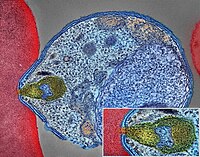
Photo from wikipedia
Malaria is a serious public health problem that affects mostly the poorest countries in the world, killing more than 400,000 people per year, mainly children under 5 years old. Among… Click to show full abstract
Malaria is a serious public health problem that affects mostly the poorest countries in the world, killing more than 400,000 people per year, mainly children under 5 years old. Among the control and prevention strategies, the differential diagnosis of the Plasmodium–infecting species is an important factor for selecting a treatment and, consequently, for preventing the spread of the disease. One of the main difficulties for the detection of a specific Plasmodium sp is that most of the existing methods for malaria diagnosis focus on detecting P. falciparum. Thus, in many cases, the diagnostic methods neglect the other non-falciparum species and underestimate their prevalence and severity. Traditional methods for diagnosing malaria may present low specificity or sensitivity to non-falciparum spp. Therefore, there is high demand for new alternative methods able to differentiate Plasmodium species in a faster, cheaper and easier manner to execute. This review details the classical procedures and new perspectives of diagnostic methods for malaria non-falciparum differential detection and the possibilities of their application in different circumstances.
Journal Title: Frontiers in Cellular and Infection Microbiology
Year Published: 2021
Link to full text (if available)
Share on Social Media: Sign Up to like & get
recommendations!